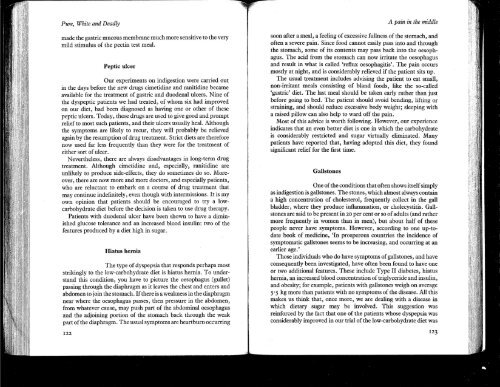John_Yudkin_-_Pure_White_and_Deadly_revised_1986_OCR
John_Yudkin_-_Pure_White_and_Deadly_revised_1986_OCR
John_Yudkin_-_Pure_White_and_Deadly_revised_1986_OCR
Create successful ePaper yourself
Turn your PDF publications into a flip-book with our unique Google optimized e-Paper software.
<strong>Pure</strong>, <strong>White</strong> <strong>and</strong> <strong>Deadly</strong><br />
made the gastric mucous membrane much more sensitive to the very<br />
mild stimulus of the pectin test meal.<br />
Peptic ulcer<br />
Our experiments on indigestion were carried out<br />
in the days before the new drugs cimetidine <strong>and</strong> ranitidine became<br />
available for the treatment of gastric <strong>and</strong> duodenal ulcers. Nine of<br />
the dyspeptic patients we had treated, of whom six had improved<br />
on our diet, had been diagnosed as having one or other of these<br />
peptic ulcers. Today, these drugs are used to give good <strong>and</strong> prompt<br />
relief to most such patients, <strong>and</strong> their ulcers usually heal. Although<br />
the symptoms are likely to recur, they will probably be relieved<br />
again by the resumption of drug treatment. Strict diets are therefore<br />
now used far less frequently than they were for the treatment of<br />
either sort of ulcer.<br />
Nevertheless, there are always disadvantages in long-term drug<br />
treatment. Although cimetidine <strong>and</strong>, especially, ranitidine are<br />
unlikely to produce side-effects, they do sometimes do so. Moreover,<br />
there are now more <strong>and</strong> more doctors, <strong>and</strong> especially patients,<br />
who are reluctant to embark on a course of drug treatment that<br />
may continue indefinitely, even though with intermissions. It is my<br />
own opinion that patients should be encouraged to try a lowcarbohydrate<br />
diet before the decision is taken to use drug therapy.<br />
Patients with duodenal ulcer have been shown to have a diminished<br />
glucose tolerance <strong>and</strong> an increased blood insulin: two of the<br />
features produced by a diet high in sugar.<br />
Hiatus hernia<br />
The type of dyspepsia that responds perhaps most<br />
strikingly to the low-carbohydrate diet is hiatus hernia. To underst<strong>and</strong><br />
this condition, you have to picture the oesophagus (gullet)<br />
passing through the diaphragm as it leaves the chest <strong>and</strong> enters <strong>and</strong><br />
abdomen to join the stomach. If there is a weakness in the diaphragm<br />
near where the oesophagus passes, then pressure in the abdomen,<br />
from whatever cause, may push part of the abdominal oesophagus<br />
<strong>and</strong> the adjoining portion of the stomach back through the weak<br />
part of the diaphragm. The usual symptoms are heartburn occurring<br />
122<br />
A pain in the middle<br />
soon after a meal, a feeling of excessive fullness of the stomach, <strong>and</strong><br />
often a severe pain. Since food cannot easily pass into <strong>and</strong> through<br />
the stomach, some of its contents may pass back into the oesophagus.<br />
The acid from the stomach can now irritate the oesophagus<br />
<strong>and</strong> result in what is called 'reflux oesophagitis'. The pain occurs<br />
mostly at night, <strong>and</strong> is considerably relieved if the patient sits up.<br />
The usual treatment includes advising the patient to eat small,<br />
non-irritant meals consisting of bl<strong>and</strong> foods, like the so-called<br />
'gastric' diet. The last meal should be taken early rather than just<br />
before going to bed. The patient should avoid bending, lifting or<br />
. straining, <strong>and</strong> should reduce excessive body weight; sleeping with<br />
a raised pillow can also help to ward off the pain.<br />
Most of this advice is worth following. However, our experience<br />
indicates that an even better diet is one in which the carbohydrate<br />
is considerably restricted <strong>and</strong> sugar virtually eliminated. Many<br />
patients have reported that, having adopted this diet, they found<br />
significant relief for the first time.<br />
Gallstones<br />
One of the conditions that often shows itself simply<br />
as indigestion is gallstones. The stones, which almost always contain<br />
a high concentration of cholesterol, frequently collect in the gall<br />
bladder, where they produce inflammation, or cholecystitis. Gallstones<br />
are said to be present in 20 per cent or so of adults (<strong>and</strong> rather<br />
more frequently in women than in men), but about half of these<br />
people never have symptoms. However, according to one up-todate<br />
book of medicine, 'In prosperous countries the incidence of<br />
symptomatic gallstones seems to be increasing, <strong>and</strong> occurring at an<br />
earlier age.'<br />
Those individuals who do have symptoms of gallstones, <strong>and</strong> have<br />
consequently been investigated, have often been found to have one<br />
or two additional features. These include Type II diabetes, hiatus<br />
hernia, an increased blood concentration of triglyceride <strong>and</strong> insulin,<br />
<strong>and</strong> obesity; for example, patients with gallstones weigh on average<br />
5"5 kg more than patients with no symptoms of the disease. All this<br />
makes us think that, once more, we are dealing with a disease in<br />
which dietary sugar may be involved. This suggestion was<br />
reinforced by the fact that one of the patients whose dyspepsia was<br />
considerably improved in our trial of the low-carbohydrate diet was<br />
123



